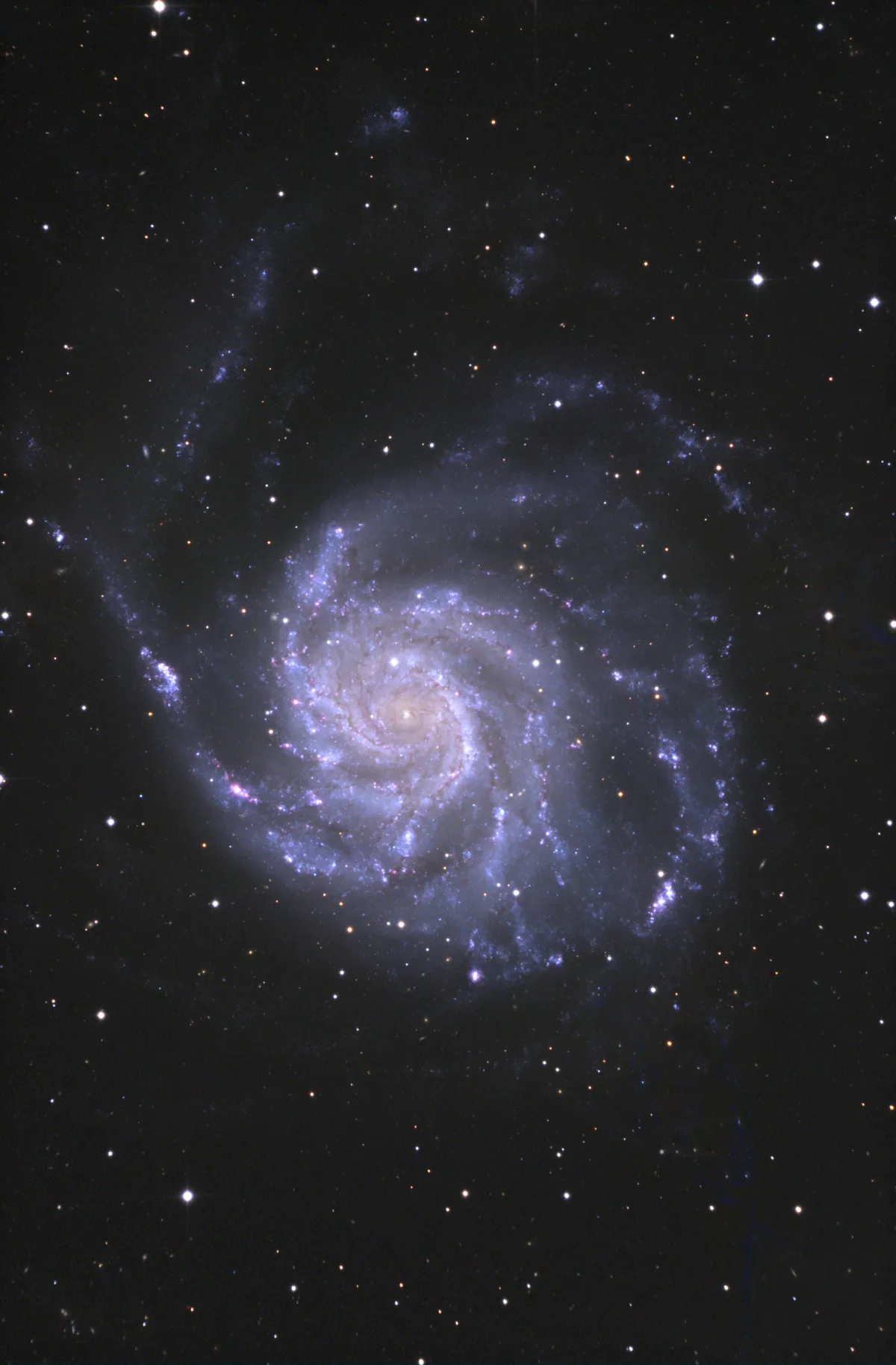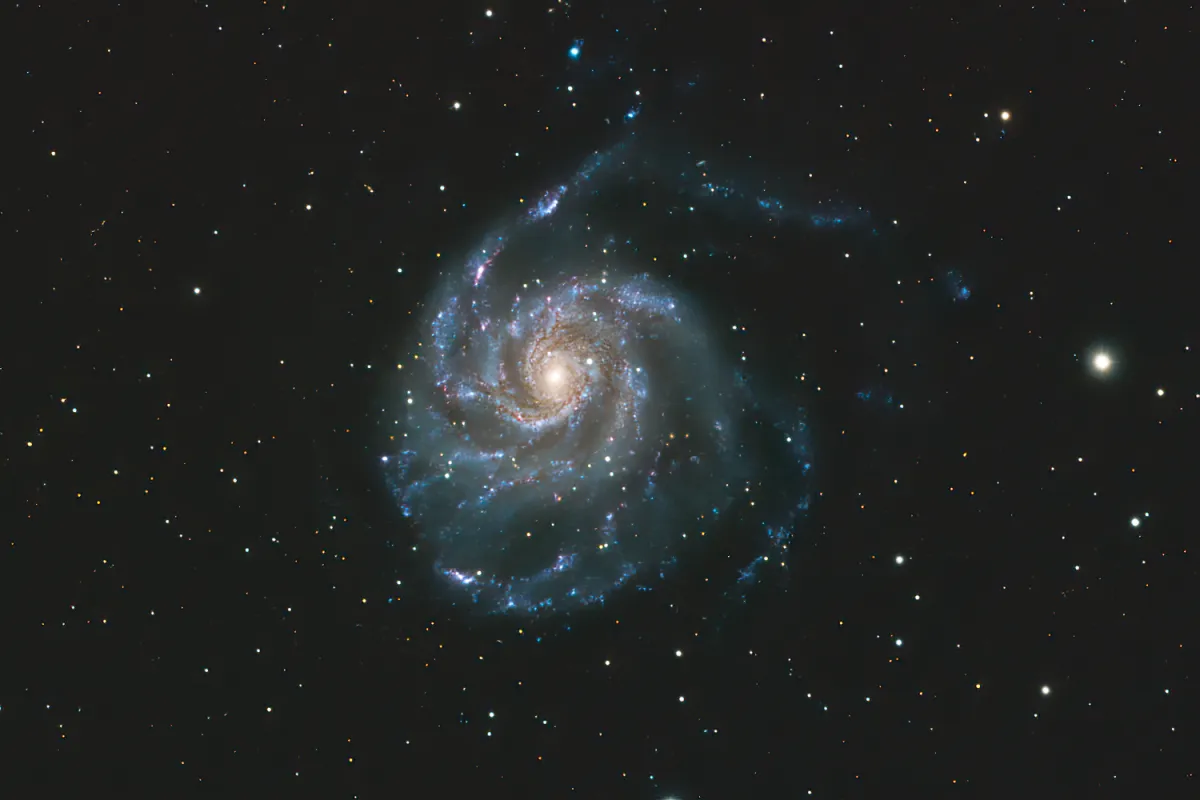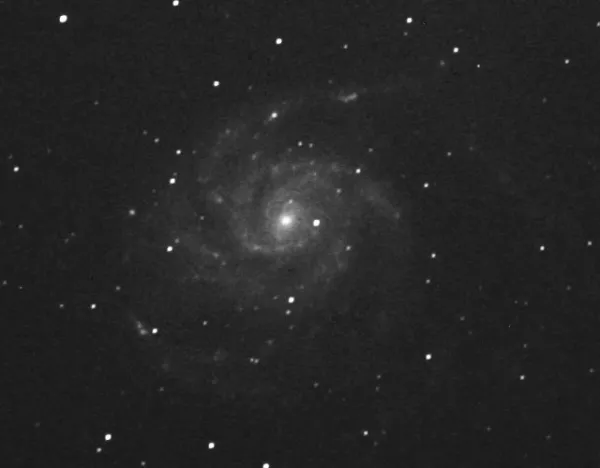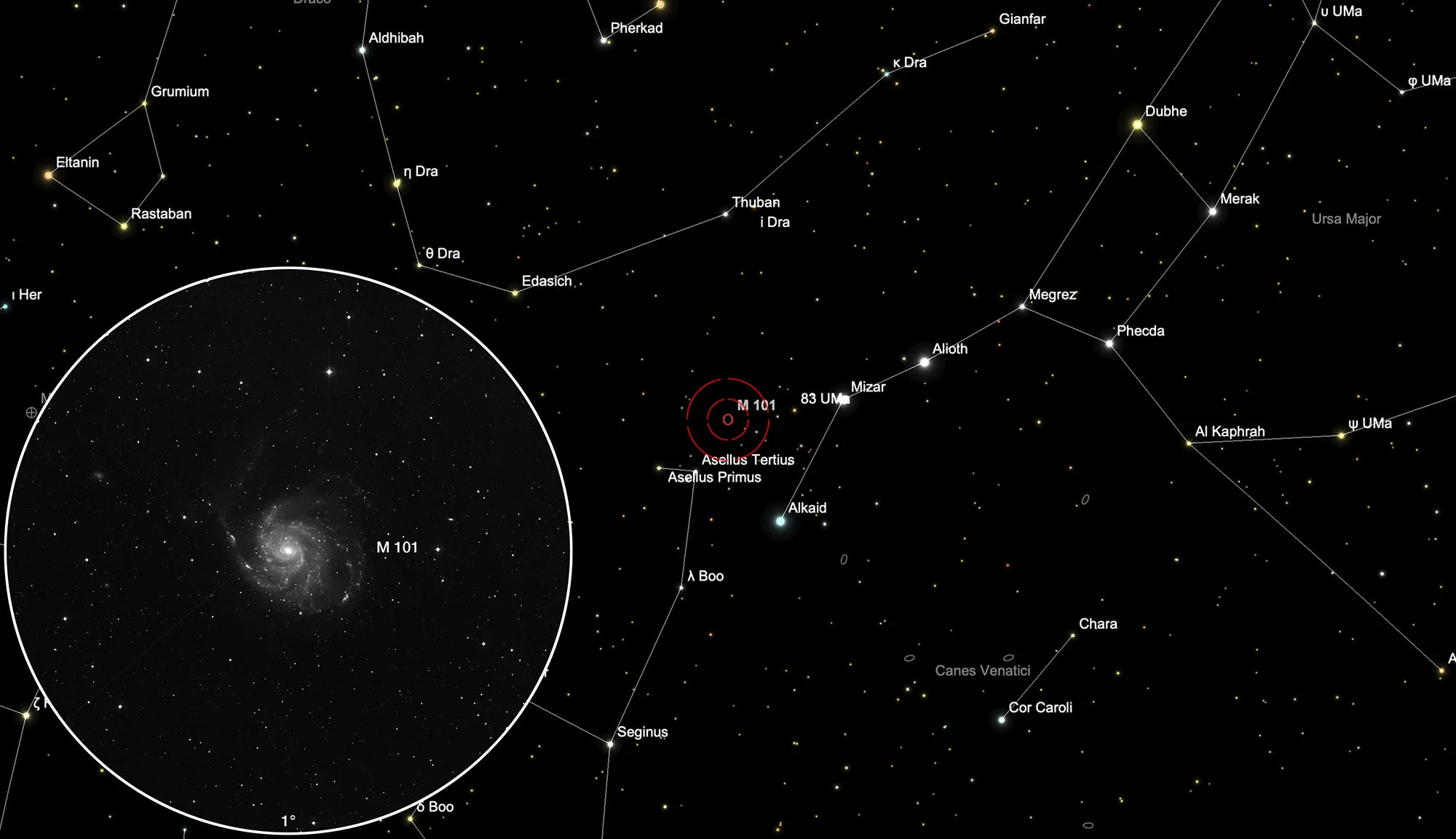Pinwheel Galaxy (Messier 101)




History
The galaxy M 101 was discovered by Pierre Méchain on 27 March 1781. Charles Messier noted without having seen her: «Nebula without a star, very dark and very large, 6 to 7 minutes in diameter, between the left hand of the boat and the tail of the Great Bear. Hard to see if you illuminate the wires [of the micrometer].[281]
A number of star clouds and bright star formation areas in the spiral arms of M 101 were discovered on 14 April 1789 by William Herschel and later on 1 March 1851 by Bindon Stoney, the engineer of Lord Rosse, and made it into NGC numbers in their own right Dreyer's «New General Catalogue of Nebulae and Clusters of Stars» published in 1888. In Halton Arp's 1966 Atlas of Peculiar Galaxies, M 101 is listed as Arp 26 for a galaxy with a thick arm. [199] The galaxy has received the nickname «Pinwheel Galaxy», a name that is sometimes also used for M 33, M 83 (Southern Pinwheel Galaxy) and M 99 (Coma Pinwheel Galaxy).
Physical Properties
The galaxy M 101 is of the morphological type SAB(rs)cd, has a heliocentric speed of about 237 km/s to 241 km/s. Distances range from about 5 Mpc to 7 Mpc. M 101 measures around 170,000 light years in diameter, almost twice the size of our Milky Way. It is believed that the galaxy contains at least a trillion stars. The spiral arms are peppered with large nebulae in which stars are born and clusters of hot, blue, young stars. [145, 194, 215]
| Name | RA | Dec | Type | bMag | vMag | B-V | SB | Dim | PA | z | D(z) | MD | Dreyer Description | Identification, Remarks |
|---|---|---|---|---|---|---|---|---|---|---|---|---|---|---|
| NGC 5447 | 14 02 29.0 | +54 16 21 | GxyP | 13.5 | 1 | 6.920 | pB, S, R, gmbM, conn with M 101 | WH III 787; GC 3760=3766; NGC 5450; part of M 101 | ||||||
| NGC 5449 | 14 02 28.2 | +54 19 53 | GxyP | 14.0 | 1 | 6.920 | vF, pL, gvlbM, all conn with M 101 | GC 3762; part of M 101 | ||||||
| NGC 5450 | 14 02 29.0 | +54 16 21 | dup | 13.0 | 1 | 6.920 | F, pS, iR, glbM, all conn with M 101 | GC 3763; NGC 5447; part of M 101 | ||||||
| NGC 5451 | 14 02 36.5 | +54 21 49 | GxyP | 14.0 | 0.3 | 6.920 | vF, pL, iR, vlbM, all conn with M 101 | GC 3764; part of M 101 | ||||||
| NGC 5453 | 14 02 56.7 | +54 18 31 | GxyP | 13.8 | 0.5 | 6.920 | F, pL, lE, vlbM, conn w M 101 | GC 3767; part of M 101 | ||||||
| NGC 5455 | 14 03 01.0 | +54 14 27 | GxyP | 13.0 | 0.4 | 6.920 | pB, pS, R, psbM, conn w M 101 | GC 3768; part of M 101 (or C gxy?) | ||||||
| NGC 5457 | 14 03 12.4 | +54 20 58 | Gx (Sc) | 8.3 | 7.9 | 0.4 | 14.9 | 28.8 × 26.9 | 26 | 0.000804 | 3.40 | 6.920 | pB, vL, iR, g, vsmbMBSN | h 1744; GC 3770; M 101; UGC 8981; MCG 9-23-28; IRAS 14013+5435; CGCG 272-21; KARA 610; Arp 26; VV 344; VV 456; Pinwheel galaxy |
| NGC 5458 | 14 03 12.4 | +54 17 56 | GxyP | 14.0 | 0.6 | 6.920 | vF, pL, R, vlbM, conn w M 101 | GC 3771; HII in M 101 | ||||||
| NGC 5461 | 14 03 41.5 | +54 19 05 | GxyP | 14.0 | 0.6 | 6.920 | B, pS, R, psbM, conn with M 101 | WH III 788; GC 3773=3778; part of M 101 | ||||||
| NGC 5462 | 14 03 53.0 | +54 22 02 | GxyP | 13.5 | 1 | 6.920 | pB, pL, iR, gbM, conn with M 101 | WH III 789; GC 3774=3779; part of M 101 | ||||||
| NGC 5471 | 14 04 28.9 | +54 23 51 | GxyP | 15.5 | 14.7 | 13.2 | 0.6 × 0.5 | 60 | 6.920 | F, S, R, * 12·13 p | GC 5757; MCG 9-23-30; VV 394; part of M 101 |
Finder Chart
Above the two stars on the tip of the Big Dipper, one reaches the sprial galaxy M101 by forming an equilateral triangle with the stars Alkaid (η Ursae Majoris) and Mizar (ζ Ursae Majoris).
Visual Observation

350 mm aperture: The brighter core can already be observed with small instruments. The fine spiral arms can only be seen under extremely good observation conditions and with the help of medium-sized amateur instruments. The weak spiral arms with their knots are clearly visible in a 12.5 or 14 inch telescope. [192]
